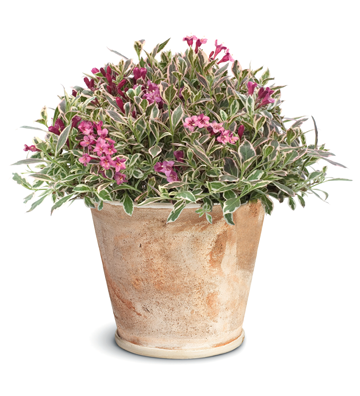

Once upon a time several years ago, Sinclair Adam Jr of Dunvegan Nursery of West Chester, Pa. He had a whole field of Phlox 'David', and lo and behold a pink mildew phlox appeared. We know 'David' is the father and we suspect 'Eva Collum' is the mother, but only the pollinators know for sure.
I trialed the plant and he called it 'Shortwood, in honor of my garden. 'Shortwood' is not short, but a medium sized phlox in bright pink. The combination produced one of the most mildew resistant phloxes on the market.
Phlox 'David' is a studly plant. In my garden'David' crossed with 'Shortwood' to producea beautiful bi-color phlox. It will be released in'08. Since I found it I named it 'Blushing Shortwood'. It's dramatic and fragrant. The end of my story unless 'David' finds a new conquest.
-------
PHLOX paniculata SHORTWOOD - PP#10379 - Tall 42" - Plant 20 " apart. Zone 4-8. The mildew resistance of P. David with the bright pink blossoms of P. Eva Cullum. Strong, sturdy stems are excellent for cutting. Forms a broad clump. A Blooms of Bressingham selection. Shortwood can be purchased on line at Bluestone Perennials.
The guest author of this post of the Plant Hunter is ...
Stephanie Cohen is "The Perennial Diva"
Known by many names throughout the horticultural world -- the "Vertically Challenged Gardener" and the "Dr. Root of Perennials," among others -- Stephanie Cohen has much to offer your club or institution.
She specializes in giving unique garden lectures, writing attention-getting, informative articles and designing award-winning garden spaces. Stephanie Cohen has taught herbaceous plants and perennial design at Temple University for more than 20 years. She is the former director of the Landscape Arboretum at Temple University, Ambler. Stephanie is a contributing editor for "Fine Gardening" and The HGTV Newsletter; sits on the advisory board for "Green Profit" and is on the advisory board of "Green Scene"; and she is a regional writer for the Blooms of Bressingham Plant Program. She also writes for "Country Living Gardener" and "American Nurseryman" magazines.
She has received four awards from the Perennial Plant Association for design, and received the group's Service and Academic Award. She has received awards from Temple University, Pennsylvania Horticultural Society and The American Nursery & Landscape Association for Garden Communicator of the Year 2000.
Stephanie has written a book on design called "The Perennial Gardener's Design Primer," which is published by Storey Press. It was the publisher's best-selling book for 2005. In 2006 she and co-author Nancy Ondra, along with photographer Rob Cardillo, were awarded Storey Publishing's Garden Media Award for the year's Best Overall Product: Book. Stephanie has started on her second book in 2006.
Stephanie has lectured coast to coast, including in Alaska. She has been on QVC TV as the "Perennial Diva." In April 2005 she became a Temple University Alumni Fellow, the most distinguished award that can be given to an alumna. She does a monthly show for CNN TV.
For more information, or to arrange a speaking engagement or consultation, please contact Stephanie at (610) 409-8232 or e-mail to info@perennialdiva.com.













